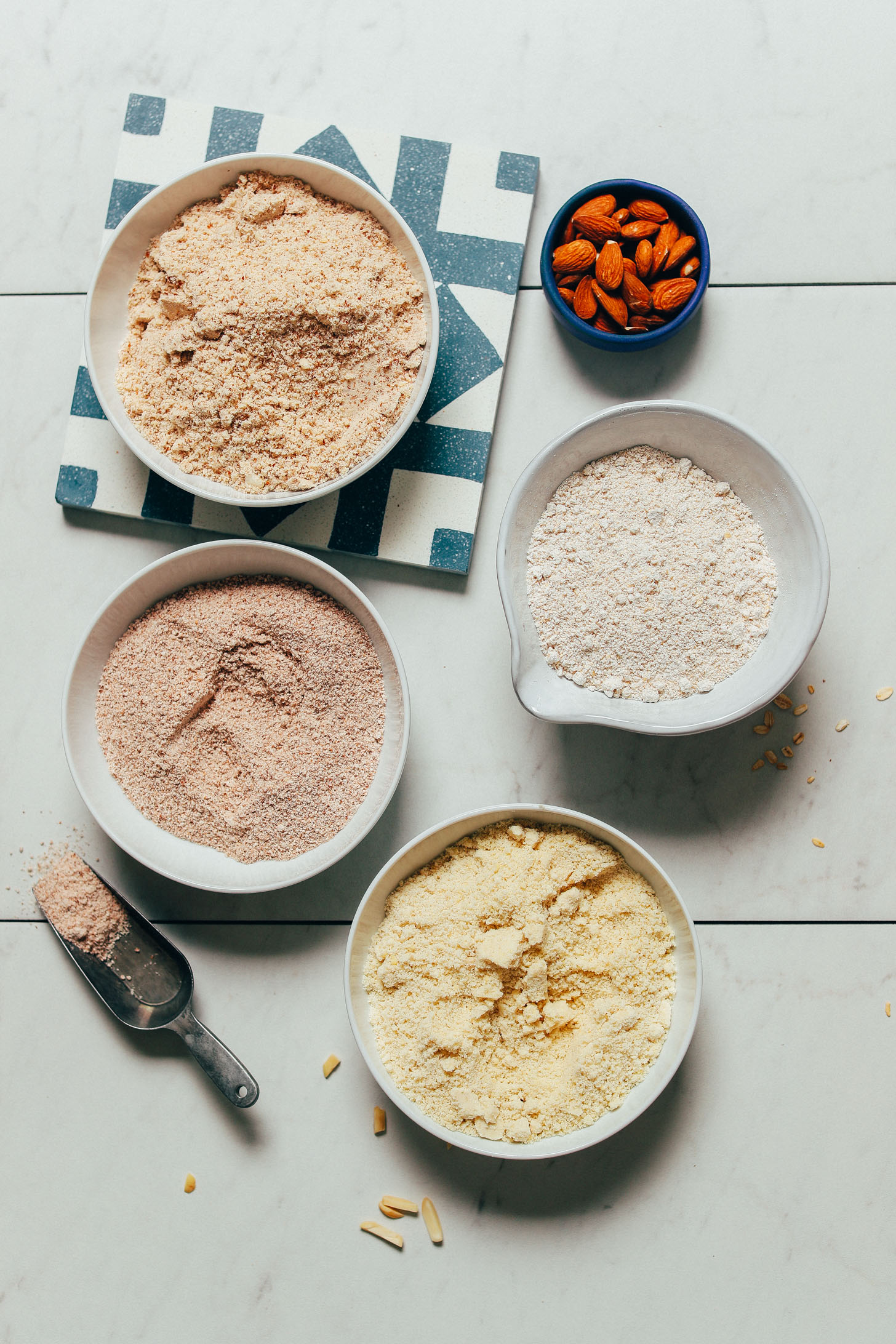
Find gluten-free baking confusing? You’re not alone.
When we first started attempting gluten-free recipes, it was overwhelming. Gluten-free flours can be expensive and daunting to know which ones to use when.
Now that we’ve been cooking gluten-free for years, we wanted to share what we’ve learned in the process, as well as a bit about our own Minimalist Baker Gluten-Free Flour Blend, and our favorite gluten-free baking recipes.
Where to Start?
We’ve found that when baking with gluten-free flours, it’s typically best to use a mix of different flours and starches to achieve the ideal texture and flavor. This is because all-purpose flour adds stretch, lightness, crispiness, and neutral flavor to baked goods. With gluten-free, you need a few different flours (depending on the recipe) to replicate these characteristics of gluten flour.
This is why we advocate for using a pre-made gluten-free all-purpose blend (like ours!) to take the guesswork out of gluten-free baking!
Before we get ahead of ourselves though, let’s dive deeper into which flours to use and when.
Gluten-Free Flours Breakdown
Consider this an educational breakdown of our most common, less common, and uncommonly used gluten-free flours.
Common Flours
Brown Rice Flour
Brown rice flour is about as close to a 1:1 substitute for all-purpose flour as it gets since it provides structure and a “wheat-like” flavor. However, because it can be gritty and dense, it works best when paired with lighter starches such as potato and cornstarch, and flours such as almond. It’s the primary base flour in our Gluten-Free Flour Blend, and also makes a great breading for things like Crispy Shallots.
White Rice Flour
White rice flour is lighter in color and texture than brown rice flour, but we still don’t use it as a 1:1 substitute in recipes where flour is called for. It can be slightly gritty and gummy. We find it works best when blended with other gluten-free flours. We included it as a thickener in this Egg-Free Frittata!
Oat Flour
Oat flour works well in recipes that require a dense texture and mild, slightly sweet flavor. It puffs up under the right circumstances – TIP: Avoid adding too many heavy, sticky ingredients to oat flour like bananas, and give it some help with a leavening agent, such as baking powder, so it puffs up and yields a lighter texture.
Not only is oat flour easy to make, it’s also rich in fiber! We find it works particularly well when making pancakes. Learn more here and try it in recipes such as our 1-Bowl Peanut Butter Protein Pancakes and 1-Bowl Vegan Banana Oat Pancakes.
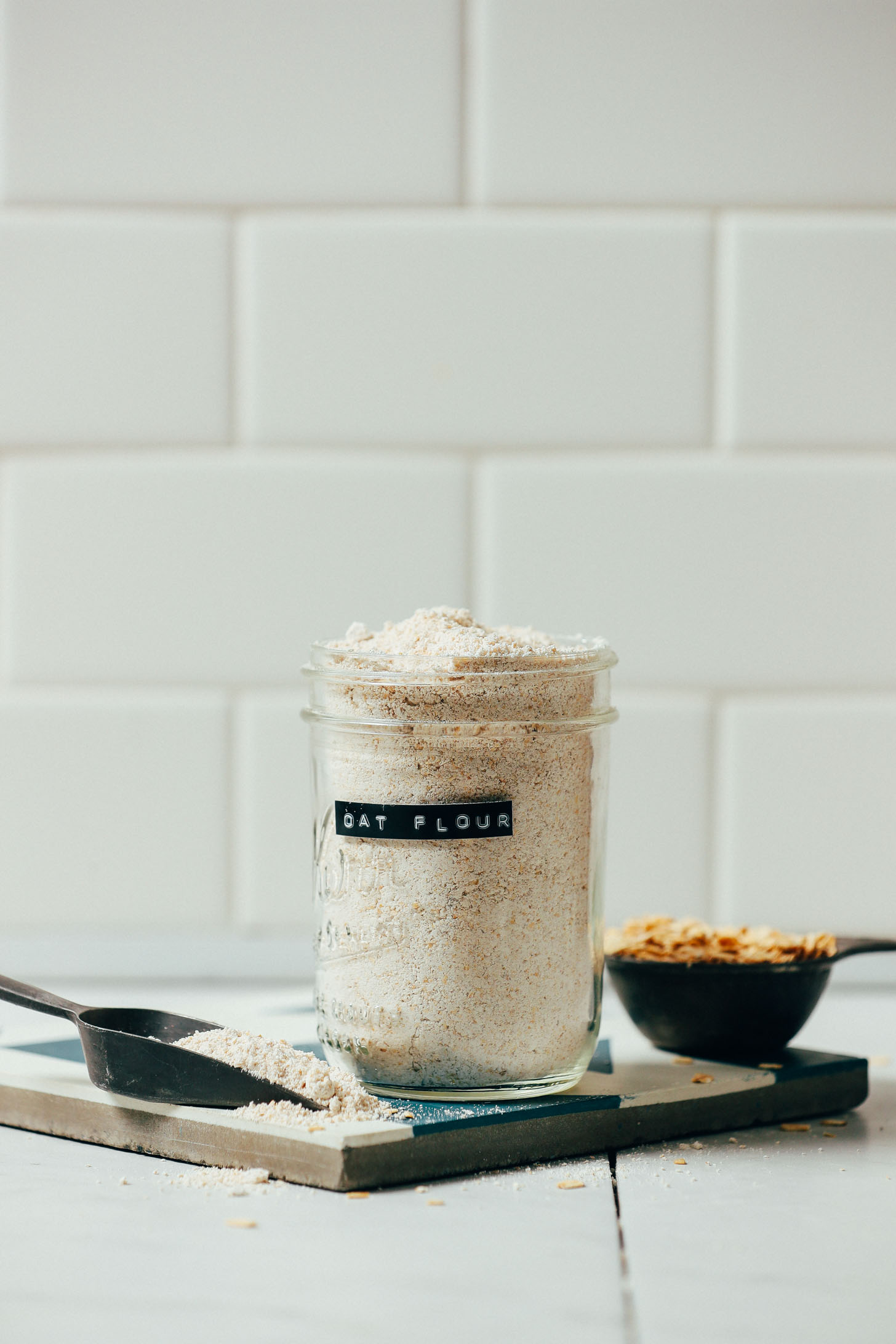
Almond Flour
Almond flour is a grain-free, protein-rich flour that lends well to cookies, cakes, and more!
Almond flour is made from blanched almonds, meaning without skins (as opposed to almond meal, which is made from raw almonds with skins). This is why it has a fluffy, light texture and pale golden color.
We often reach for almond flour in baking recipes when we’re looking for a light, fluffy, cake-y texture with neutral flavor, because almond flour has a milder flavor than almond meal, and tends to fluff up nicely when baked! It works well in both egg and egg-free baking.
Learn more here and try it in recipes such as our Perfect Vegan Gluten-Free Chocolate Chip Cookies, 1-Bowl Vegan GF Vanilla Cake, and 1-Bowl Vegan Gluten-Free Carrot Cake.
*Find our favorite store-bought Almond Flour here.
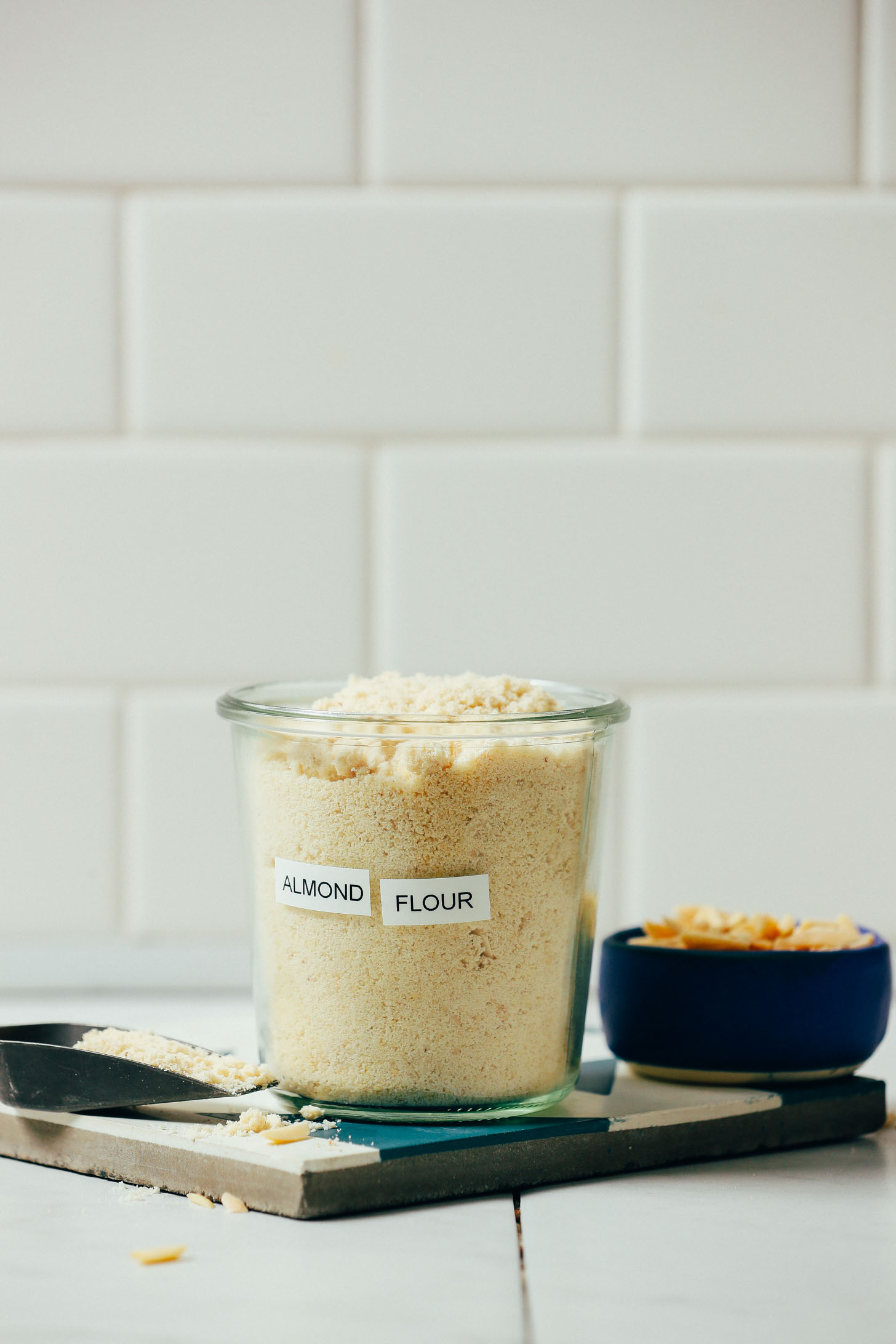
Almond Meal
Almond meal is made from raw almonds with skins and lends a slightly more wholesome texture in recipes than almond flour – its blanched counterpart.
Almond meal and almond flour are not ideal to be used interchangeably, as almond meal works best in heartier baked goods like wholesome muffins, cookies, and crackers, whereas almond flour is best in cakes and light baked goods.
Learn more here and try it in recipes such as our Banana Almond Meal Muffins (Gluten-Free + Vegan) and 1-Bowl Vegan Gluten-Free Crackers.
Note: One of the reasons we like to use almond meal is it can be made from the leftover pulp from making Homemade Almond Milk! When subbing Almond Meal made from Almond Pulp in a recipe that calls for almond meal, you may need to slightly increase the amount of oil or liquid to add back in moisture that gets lost in the process of making almond milk.

Cornstarch
Though technically a starch (not a flour), we rely on cornstarch often in gluten-free recipes. It makes a great thickener in things like puddings, sauces, and compotes, and can even add neutral-flavored structure and a crumb-like, light texture to baked goods!
See our favorite ways to use cornstarch in our Gluten Free Vegan Biscuits, General Tso’s Tofu Stir Fry, Vegan GF Peanut Butter Cup Cookies, and Cashew-Less Vegan Queso.
Tapioca Starch (a.k.a. Tapioca Flour)
We don’t typically use tapioca starch on its own in recipes as it can yield quite a sticky, stretchy texture. However, it is neutral in flavor, making it a great option for gluten-free blends. Our favorite recipe with tapioca starch is definitely our Easy Vegan Mozzarella “Cheese” which utilizes tapioca for that quintessential stringy cheese texture!
We’ve also been loving it to add crispness to recipes like our Thin Mint Cookies, because in recipes without much liquid, it browns well and adds a nice snap!
Potato Starch (NOT Potato Flour)
Potato starch works well when trying to achieve a light, cake-y texture, such as in our 1-Bowl Vegan Gluten-Free Vanilla Cake. We don’t typically use it as a 1:1 substitute in recipes where flour is called for, but it works well when blended with other gluten-free flours, including almond flour.
It’s become one of our most-used ingredients when we’re trying to achieve a cake-like texture as it pairs very well with almond flour. Try it in our Gluten-Free Flour Blend, Best Gluten-Free Chocolate Cake, and Vegan Gluten-Free Pancake Mix!
Less Common Flours
Sorghum Flour
Sorghum flour can be a substitute for oat flour, although it is slightly more gritty and provides less binding. It has a mildly sweet flavor and tender crumb. Sorghum lacks binding capability, so pair with an absorbent and stretchy flour or starch like tapioca.
It’s great in pie crusts, cakes, muffins, breads like our Best No-Knead GF Bread and Fluffy Gluten-Free Focaccia, and cookies like our Cranberry Macadamia Nut Cookies.
Buckwheat Flour
Despite the name, buckwheat contains no wheat and is actually a grass related to rhubarb. It’s dense and absorbent and great in recipes that have a strong flavor, like chocolate, spices, or banana.
We like to use it to add a wholesome flavor to things like our Buckwheat Crepes, 1-Bowl Banana Buckwheat Muffins, and Spiced Buckwheat Pancakes in our Everyday Cooking Cookbook.
Cassava Flour
Cassava flour is mild in flavor and provides a light texture to baked goods. It’s also very absorbent and pairs well with brown or white rice flour to add structure without too much grittiness. It’s grain-free and can be used as a 1:1 for all purpose flour in some recipes.
We like it in tortillas, cookies, and crackers, and it’s also featured in our MB Gluten-Free Flour Blend!
Arrowroot Starch
Arrowroot starch is extracted from a tropical plant. It can be used interchangeably with tapioca and cornstarch, but is less stretchy than tapioca, and more stretchy than cornstarch. It can become gelatinous if too much liquid is added (such as in puddings). Similar to cornstarch, it’s also great for coating and pan-frying things like tofu.
See a few of our favorite ways to use arrowroot in our Gluten Free Vegan Pizza Crust, Best Vegan Gluten-Free Mac ‘n’ Cheese, Easy Vegan Caramel Sauce, Vegan Lemon Curd, and Cinnamon Baked Apples.
Coconut flour
Coconut flour is a very dense flour made from dried coconut meat. It typically does not substitute well in recipes using a 1:1 ratio, and almost always benefits from having an egg in the mix since it’s so dense. It can brown but won’t crisp up as it’s quite fatty. It’s rich in fiber, more absorbent than most other gluten-free flours, and really shines in no-bake treats like our Carrot Cake Bites. It also works well in recipes that use eggs, such as our Banana Egg Pancakes.
Chickpea Flour
Chickpea flour (also known as gram flour) is great for making Socca and Egg-Free Frittatas! It has a strong bean flavor and can be quite dense, so it doesn’t work well in sweet baked goods.
Cashew Flour
A close substitute for almond flour, cashew flour is made of raw ground cashews! Not super common for our kitchen, but a good substitute in a pinch.
Uncommon Flours
Our least commonly used flours include: chestnut, teff (highly nutritious but hard to find), banana flour (dried ground bananas!), millet flour (nutritious but bitter), tigernut flour (can be used in place of almond flour but hard to find), and quinoa flour (also somewhat bitter and earthy).
Our Gluten-Free Flour Blend
Now that you know a bit more about the nuances of gluten-free baking, you can understand the benefits of a really well-balanced, all purpose blend that takes the guesswork out of gluten-free baking.
Our Gluten-Free Flour Blend is a staple in our kitchen. It relies on brown rice and white rice flour for structure, potato starch for lightness and lift, tapioca starch for stretch and binding, and cassava flour for its mild flavor and ability to absorb liquid. Xanthan gum is also included in a very small amount to provide more stretch. It’s a perfected, more versatile version of our first DIY blend from the blog.
Our blend is reliable, thoroughly tested, and an effective 1:1 replacement for all purpose flour in your favorite recipes like quick breads, brownies, cakes, cookies, flatbreads, pie crust, breading, and more! Here are some of our favorite recipes to put it to use!
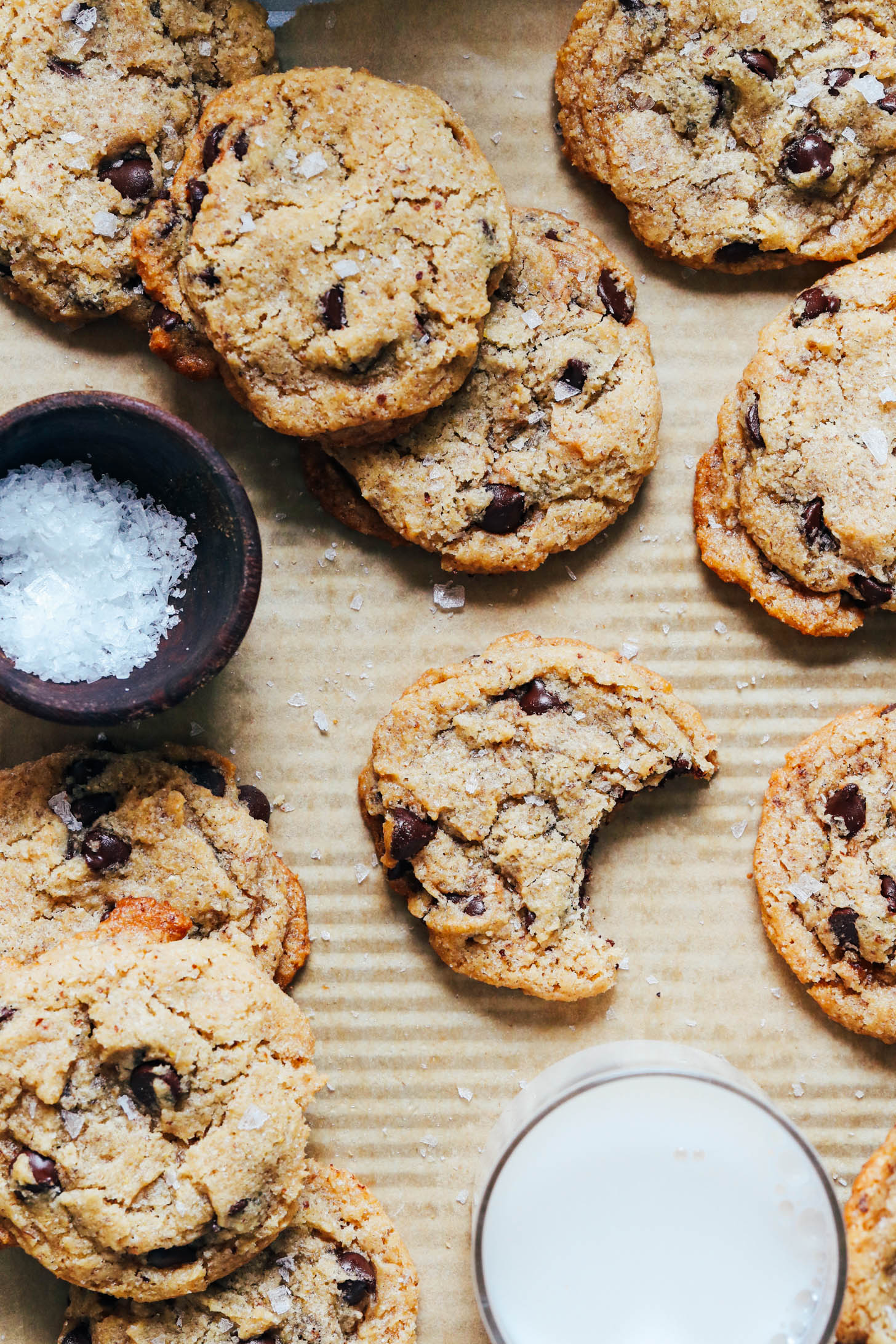
Can you make your own flours?
Yes! Making homemade gluten-free flours saves money and allows you to better control the consistency, flavor, and freshness of your ingredients. We like to stock our pantry with the following homemade flours for gluten-free baking:
How to Make Oat Flour
How to Make Buckwheat Flour
How to Make Almond Flour
How to Make Almond Meal
How to Make Almond Meal from Almond Pulp!
And this concludes our Guide to Gluten-Free Flours! We hope you learned something new and found this resource helpful. Now, put it to use! Find all of our Gluten-Free Recipes here.
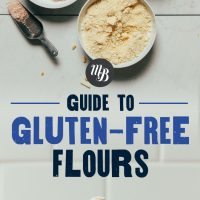
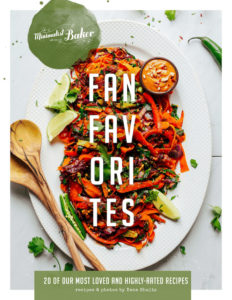
Suz says
Thank you so much for this comprehensive look at flours. I’ve started an adventure making GF-sourdough bread and trying different flour and starch combinations. Your article identified why my bread had an unpleasant bitter-like aftertaste. I blamed my starter but now I see it was probably the millet.
Ah, yes! Millet can be tricky. We’re so glad this article was helpful! Thank you for sharing and best of luck with your GF sourdough! xo
Beverly says
I have been baking gluten free for 10 years and still love learning. I recently read that LUPIN FLOUR can sub for almond flour in baking gluten free.
Best results in baking come by WEIGHING the ingredients rather than using measuring cups. Professional bakers use weights not measuring cups.
For example Minimalist Baker’s GF Flour Blend weighs 160 grams per cup. Bob’s Red Mill 1:1 GF Blend weighs 148 grams for 1 cup.
Jeri says
I want to make gluten-free oatmeal cookies and need a blend Recipe for the different flours I have.
Hi Jeri, we would recommend this GF blend. Hope that helps!
C Macdonald says
I have been gluten sensitive since about 2012, but since 2019 I have also become allergic to corn, potato, sorghum, and sesame.
Are there any workable substitutes for corn and potato starch, as well as sorghum? I have always loved to bake, and feel like a part of me is missing since I have not been baking cakes, breads, etc. Your website is one of my favorite for finding good recipes, but I really, really want to make your gluten-free chocolate cake…I miss cake…I miss crusty bread…I miss the textures of the foods I loved to make. *sigh* (Apologies for make a simple question so complicated.) Thanks!
We’re so sorry you’re dealing with so many allergies! That’s definitely tough. It’s really hard to get a light and fluffy result in vegan + gluten-free baking without potato starch or cornstarch. You could possibly experiment with a combination of tapioca, arrowroot, and cassava flours? Or if not vegan, eggs would help add some fluffiness.
C-Mo says
I’ve been a huge fan of your website for years, ever since I first discovered it. Now I see what looks like a package of your own GF 1-1 flour mix pictured on this page, but I don’t see it listed as an option to buy on your “shop” page.
Can we buy it anywhere?
Please?
Thanks so much for your support over the years! We’re so glad you enjoy our recipes. The gluten-free flour has been discontinued, but if you’re up for making it from scratch, we have a recipe here: https://minimalistbaker.com/best-gluten-free-flour-blend/. Hope that helps!
Katie says
Discontinued?! I’m sure I missed the announcement, but was it just too much on your plate (bleh pun) to have produced? Supply chain, inflation, etc? I SWEAR by the blend (and so much easier than getting all the ingredients AND perfectly measured, a feat I am terrible at). Would you recommend another “gluten free flour mix” that exists in the world?
Hi Katie, you’re spot on! So sorry for the inconvenience. We’re really proud of the products we created. Ultimately, it was really challenging facing supply chain issues, getting gluten-free certifications, and getting them to people’s homes at an affordable cost, especially with a worldwide audience. To make them more accessible to all, we decided to share the recipes on the blog and discontinue the product line. We appreciate your enthusiasm for and support of our products! We’d say Bob’s Red Mill 1:1 GF Baking Flour is the best alternative, but still not a true 1:1 in our experience.
Katie says
No, this is completely understandable! I’m so sorry you had to deal with the frustrating downsides and I am SO grateful that you at least gave it a whirl so we could all try it the Easy Way :) I’m also grateful for the substitution recommendation! I’ll try it, and if it’s just not the same, I’ll muscle up the courage to create your version since it is truly perfect! Thanks again!
Thanks for understanding, Katie! We hope you land on something you enjoy just as much :)
CJ Bailey says
I have a 2 1/2 year old grandchild recently diagnosed with many allergies. Nuts, soy, potatoes, corn and rice, to name a few. I am experimenting with green banana flour, sorghum and cassava. Can you suggest a ratio for a flour blend, or suggest additions? BTW, made her pancakes with the banana flour that were amazing, and pasta that we have not cooked yet.
Thank you!
CJ Bailey
Hi CJ, we don’t have much experience with banana flour but you might have success with a blend of those flours! You could possibly include some tapioca starch as well, for extra structure (it’s the same plant as cassava, just the isolated starch). If your grandchild can have oats, oat flour could also be worth including. You can reference our DIY blend if it’s helpful for referencing ratios, but you probably want a decent amount of sorghum and less of everything else. Good luck!
Raylee says
I’m trying to find recipe of gluten free flour ! Not using rice almond or millet! Having arthritis grain arent good and holding oxalates rules almond out , I’ve got tapioca chickpea buckwheat oat and cassava , is it possible to get quantity of any of these to use in baking! I randomly mix but I’m sure there’s some clever person who can give mea recipe! Thank you in advance , Raylee
Hi Raylee, we will add it to our list!
Sweetpeasmama says
Raylee, make note that tapioca and buckwheat are also high in oxalates. Low in oxalates are potato starch and white rice, so I’m on the hunt for something I can make with those!
Atara Dahan says
What can I mix with buckwheat flour to make lighter, fluffier baked goods?
Would potato starch work?
That’s a good idea! We haven’t tried that combo ourselves, though. Let us know how it goes!
marigael says
I make a buckwheat flour pancake which turns out light and fluffy. I think the leavener is what creates that lightness. The recipe has a combination of buttermilk and baking soda. Maybe give that a try.
Chae says
What are your thoughts on einkorn flour as a low gluten substitute?
Hi Chae, we haven’t experimented much with Einkorn flour, but know the store-bought bread tends to be dense. Not sure if that’s due to the properties of the flour or other factors? Nutritionally, it does seem promising!
Eve says
Do I need to use a starch if I am using oat flour with egg, baking soda and either yoghurt or lemon juice for rising? I am trying to understand the gluten-free flour blends and why I need more than just oat flour to bake with. I would prefer adding another lighter flour that I can make myself. Rice flour seems too heavy for oats? Do I need another flour or can I just adjust the ingredients to make it fluffier? Thank you!
Hi Eve, we find oat flour on its own is more dense and gummy, but it can work depending on the recipe. To lighten it up, starchy flours like potato starch, corn starch, tapioca starch will help.
Erin says
I need to make a GF carrot cake this weekend. I have an excellent recipe for carrot cake made with all purpose flour (so clearly not GF). So I am wondering if I should search for a GF carrot cake made with almond flour, or if I would be fine to make my regular recipe, but with a GF flour blend in place of all purpose flour. Which option would likely give better results?
Hi Erin, we find a blend of gluten-free flours is important for the right texture. We have a carrot cake recipe here. Hope that helps!
Kara DeMeio says
Left a response earlier; perhaps part rice and tapioca, to part coconut, and sweet potato flour, or no coconut? If that’s an idea? It would be softer item, the sweet potato biscuits I mentioned in a few days ago question. Corn would not hurt as long as its maybe meal? Any clues to a blend?
Hi Kara, rice, tapioca, sweet potato, and a small amount of coconut sounds promising. But it’s hard to know without trying it!
Kara DeMeio says
Needed to know; trying to adapt my aunt’s sweet potato biscuits to be both gf and dairy free, thought using sweet potato flour and a coconut flour might be too much or since these biscuits are very flat and softer, I could get away with coconut oil or applesauce in place of butter. Any ideas if this will work or be a flop? Had my gallbladder removed and it flips over grains and dairy, potato, corn, anything much for a slow transit. This is for November, and my relatives now also have a slew of intolerances with their kids’ diets. My cousin has like me, pcos, so I want to help and make the food taste alright again.
Hi Kara, we haven’t experimented with sweet potato flour, but find coconut flour to be quite dense and absorbent. We’re thinking you’ll need to add some type of less dense flour with those two. Normally we’d say potato starch, but since that’s off the table, maybe tapioca or arrowroot (if you can have those?). Hope that helps!
kate says
I have been enjoying making some of your recipes. I am making your GF flour, I dont have white rice flour, can I substitute with another flour or do you recommend the white rice flour for best results. Thank you Kate
We’re so glad you’re enjoying our recipes, Kate! Brown rice flour + more potato starch might work in place of white rice flour. Or a lighter flour such as sweet sorghum flour? Hope that helps!
Victoria says
Hi!
Do any of your other recipes use coconut flour? :)
Thanks!!
Hi Victoria, we have a handful of recipes with coconut flour. You can find them here. Hope that helps!
Christine says
I am gluten intolerant and also potato intolerant. It seems like all the gf blends have potato starch. What can I use to substitute for the potato starch?!?!?
Hi Christine, ah, yes. That’s because potato starch is pretty unique in its ability to make GF baked goods fluffy. But we’d say your best bet would be to use a mix of more brown rice flour, white rice flour, and tapioca flour in this GF blend. Hope that helps!
Char says
Hi! I was wondering if you think the bob’s red mill gc flour blend is any good for most baked recipes?
Hi Char, the 1:1 GF Baking Mix (in the blue bag) is similar to our GF blend and can be used in many of our recipes. We aren’t as fond of the GF all purpose blend (in the red bag). Hope that helps!
Beverley says
Would you please experiment and share with us, using millet and buckwheat as the main ingredients in a flour blend.
These 2 grains leave an alkaline and neutral, respectively, residue and are valuable for people with any inflammatory chronic disease
We will have to do more experimenting and let you know! xo
Mila says
Ok so instead of 1/4 white rice flour and 1 1/2 brown rice flour, I would use 1 3/4 sorghum flour? And recipes that require oats I would replace with quinoa flakes using the exact measurement of the oats?
Thank you
Hi Mila, Sorry for any confusion! I thought you had commented on this recipe: https://minimalistbaker.com/diy-gluten-free-flour-blend/. Yes, that’s what we would recommend. But we can’t guarantee results as we haven’t tested with these modifications. You can also search the comments on specific recipes to see what others have tried. To search, press “ctrl+f” on a PC or “command+f” on a mac. Hope that helps!
Daniela Villanueva says
Great information. Now that my husband has IBS he tries to avoid gluten and I want to be able to make him some goodies. Time to go shopping for some pantry staples.
We’re so glad it’s helpful, Daniela! Thanks for sharing!
Irene says
Super helpful and informative, thank you! I was hoping there would be a mention on cassava flour. Have you experimented with it yet? I’m wanting to bake a vegan cake with it but not sure if it’s a 1:1 substitute for the whole wheat flour it calls for.
So, cassava hasn’t been our friend. Mostly because it seems to have a strong flavor and when we’ve added it to recipes it often overpowers.
Michelle Belan says
I’m surprised to hear that about cassava flour – I think Otto’s flour is quite versatile and has much less of its own flavor than either almond, chickpea, or even coconut flour. I can’t use corn, potato, or oat flour, and just started experimenting with the rice flours. I’ve been eating some breads that also use sorghum and seem to be ok with it. But I’d love to expand my baking repertoire with Otto’s and am curious about your experience. Not sure if you can elaborate on what flavor you noticed?
Hi Michelle, agreed that it has less of a strong flavor than chickpea and coconut. The smell/flavor is more earthy in our experience.
Tiffany says
Hi! I’m making this recipe: https://eatplant-based.com/vegan-chocolate-cake/
They referenced this web page & that’s how I found you.
I’m a little confused. What will work best in replacement of the whole wheat flour? The DIY blend itself, or the DIY blend +oat flour +almond flour?
Thank you SO much for helping me. I appreciate that this guide to gluten free flours even exists. You make a difference! :-)
I’d say the DIY blend and oat flour + almond flour for best texture! Good luck, Tiffany!
Autumn says
For the gluten free vanilla vegan birthday cake, could I possibly use oat flour instead of almond flour and all corn starch instead of corn and potato starch? Thanks!
Hi Autumn, maybe, but we haven’t tried with those modifications so we can’t guarantee results. Almond flour has a higher fat content compared to oat, so we’re a little hesitant on that. Let us know if you try it!
Tessa says
Hi
My housemate is celiac and can’t have oat flour (even gluten free oat flour) but many gluten free recipes call for GF oat flour. What would be a good substitution for it?
Thanks!
Hi Tessa, it will depend on the recipe, but we’d say buckwheat flour (ground from raw buckwheat groats) or quinoa flakes/flour would be the best options.
Ignacio says
Hi! I’m doing gluten free waffles! I’m currently using Rice flour. Should I still use only rice flour? Or combine it with some corn starch, tapioca, etc. Thanks
Hi Ignacio, we’d recommend a combination, such as in this recipe. Hope that helps!
Sofie says
If I wanted to make a simple vanilla cake, would almond flour or oat flour work best?
Hi Sofie, we like to use a blend of gluten-free flours for best results. When used individually, they don’t typically produce as desirable a texture/flavor.
Cph Media says
So if a recipe calls for a heavy flour like almond (and I already have a zillion different flours but not that one), can I just substitute it for any of the other heavy flours and get the same or similar results?
It will depend a lot on the specific recipe, but it might work with some!
Sarah Hadi says
Hi! i want to make sweet potato brownies but i want it to be keto, so if i were to replace the oat flour with almond flour, would the measurements be the same ?
We haven’t tried it that way, but it might work! Let us know how it goes!
Natalia says
Hi. I love the taste of almond flour but I don’t like the texture. I made banana bread and muffins and it was too wet to my liking. Can I combine almond flour with oat or coconut flour to get a fluffier texture?
Hi Natalia, Oat and coconut are also dense. We would probably recommend combining it with a gluten-free all purpose blend, tapioca starch, and/or potato starch.
Louise says
sweet potato brownie recipe –
1 cup mashed, cooked sweet potato,
1/4 cup cocoa powder, 1/2 cup nut butter,
1/4 cup maple syrup.
combine ingredients thoroughly, place in small loaf pan and cook for 12-15 minutes at 350F.
No flour required at all.
Kris says
Thanks so much for this great info! We love baking with almond flour, but have grandkids who are allergic to all nuts. How much GF flour (a blend like your homemade or Bob’s Red Mill) would you substitute when a recipe calls for almond flour. Thanks so much in advance!
Hi Kris, it will depend on the recipe. We would recommend commenting on the specific recipe as sometimes it can be subbed and other times it will impact the texture too much. To see what others have tried, you can press “ctrl+f” on a PC or “command+f” on a mac and a find bar should pop up that allows you to search for specific words (such as “nut allergy”) in the post and comments. Hope that helps!
Kris says
Thanks so much!
Nina says
Hello! Tapioca flour, is it the same as white tapioca pearls? Do I grind the pearls?
That should work!
Nina says
The pearls came out quite hard. Does one have to soak the pearls or mill them? Is tapioca flour just the pearls milled or something else?
Hi Nina, grinding them in a spice grinder or high-speed blender should work. Is that what you tried?
Maria says
Hi! I have a question, when I do that mix I can replace it for the flour by that exact same amount? Because I tried baking a cake replacing the exact amount and it didn’t work
Hi Maria, we find it can sometimes be used 1-1 in recipes, but gluten-free baking is a little more tricky! We typically like to use a combo of GF blend, almond flour, and/or oat flour. If you look at some of our baking recipes, you can get an idea for how we like to use it. Hope that helps!
Haleigh says
Hello!
I love your blog! So helpful -Thank you! I received a Cook book that uses mix of flours and Xanthan gum. While I often do make my own blend-I do have Bob’s red mill flour-1-1. If the recipe calls for 1/2c sorghum flour, 1/3cup tapioca flour ect.- do you recommend adding up the flour quantities in the recipe and add the equivalent of the 1-1 flour?
I’d say so! It’s hard to say without looking but that would be my guess.
Yuta says
I’m looking for a coconut flour rusk recipe and I’m not winning. A seedless, buttermilk sweet rusk. Coconut flour if possible, as it’s the most affordable flour in South Africa. I’m on Keto and I miss buttermilk rusks. Almond flour/meal is expensive in South Africa. Do you perhaps have a type recipe I can use for low carb buttermilk rusks?
I’m not sure what a rusk is! Mind explaining?
Sadia Rehman says
It’s like a cake, but when u bite into it its dry and crisp like a biscuit
Elyse Simpson says
I’m also in South Africa and look forward to your reply on this. A rusk is a bit like South African biscotti; like a sweet, crunchy cookie.
Hmm, we aren’t sure of a low carb version, but maybe something similar to this for a sweet, crunchy cookie: https://minimalistbaker.com/vegan-gluten-free-banana-pecan-shortbread-butter-free/
Kali says
I have tried some of your recipes (brownies and lemon bars for ex) and I love them!!!
It is a treat but feels nourishing at the same time.
I am looking for a classic pie crust for an apple pie for example but gluten free of course as I am celiac.
Any suggestions?
Thanks
Kali
Hi Kali, you could try a gluten-free flour blend in this recipe: https://minimalistbaker.com/pumpkin-spiced-apple-pie/. Hope that helps!
Emily says
I have absolutely loved the recipes on your site, but I unfortunately have an almond allergy. Would subbing a rice-based gluten free flour blend work in most of your recipes that call for almond flour? Or would you recommend substituting ground up sunflower or pumpkin seeds?
Not necessarily, the two have different textures / behave differently in recipes. Sorry but I can’t recommend a 1:1 swap for every recipe. If there’s a recipe you are curious about using a substitute for, comment on that recipe and we’d be happy to help!
Beverly says
I have been baking gluten free for 10 years and still love learning. I recently read that LUPIN FLOUR can sub for almond flour in baking gluten free.
Best results in baking come by WEIGHING the ingredients rather than using measuring cups. Professional bakers use weights not measuring cups.
For example Minimalist Baker’s GF Flour Blend weighs 160 grams per cup. Bob’s Red Mill 1:1 GF Blend weighs 148 grams for 1 cup.
Cheryl says
Thank you for sharing these GF flour combinations. I am allergic to rice and flax so do you have some substitutions for the rice flour in your GF flour?
Hi Cheryl, another reader mentioned in the comments of this recipe that they successfully substituted rice flour with quinoa flour! We haven’t tested with this modification, but if you do try, let us know how it turns out!
Anonymous says
Are you allergic to millet? I find millet flour to be a good sub for rice flour. Ground chia seed can sub for flax meal. Good luck! (I love the recipes here, by the way. Thank you Dana!)
Thanks for sharing!
Emaleigh Downey says
This is amazing. I have sent it to friends and family for a concise explanation of everything GF flour! You are great!
So glad you enjoyed it! Thanks so much for sharing, Emaleigh!
ReaderRita says
This is great- thank you. I love that you linked to recipes with each ingredient!
Lisa says
Hello! Thank you for all of the information! Would arrowroot starch be a suitable replacement for potato starch? I have sensitivities to potatoes.
Yes people have been having success with that, but we haven’t tried it ourselves and can’t guarantee it’ll work in every recipe!
Lisa says
Thank you for letting me know!
sophie ashworth says
Thank you! V useful
Ross Gibson says
At my local bulk Barn, they frequently have Teef flour, and I’ve really enjoyed using it as a substitute for flour in more savory dishes. It’s great in meat loaf, and in pie crusts for meat pies. It definitely binds things together a lot more consistently. I’ve even used 1/4th cup to 2 cups almond when making cookies to give them some good structure almond flour tends to lack. I’m no professional, but it’s an interesting flour to try.
Fascinating! Thanks so much for sharing, Ross!
Jim Webb says
Hi. You have a fine site. I wss diagnosed a celiac 45 yrs ago. Believe me nothing was available. I do all my gluten free baking. I must say ive seen the changes over yhe years.
If i may id like too share my diy gf flour blend. I use it for all my baking, it works very well. Regads james webb
1c brown rice
1 1/4 white rice flower, but i sub with quinoa, amaranth, or light buckwheat.
1/4c potato starch, not potato flour
2/3c tapioca starch
3/4c sweet rice flour
1/3c corn starch
2 tsp xanthan or guar gum
1/4c ground flax
I usually make a double batch and store it in a air tight container in a dark cabinet
Thanks so much for sharing, Jim!
Carole Allen says
Outstanding, well written! Superb recipes.
Thanks so much, Carole! xo